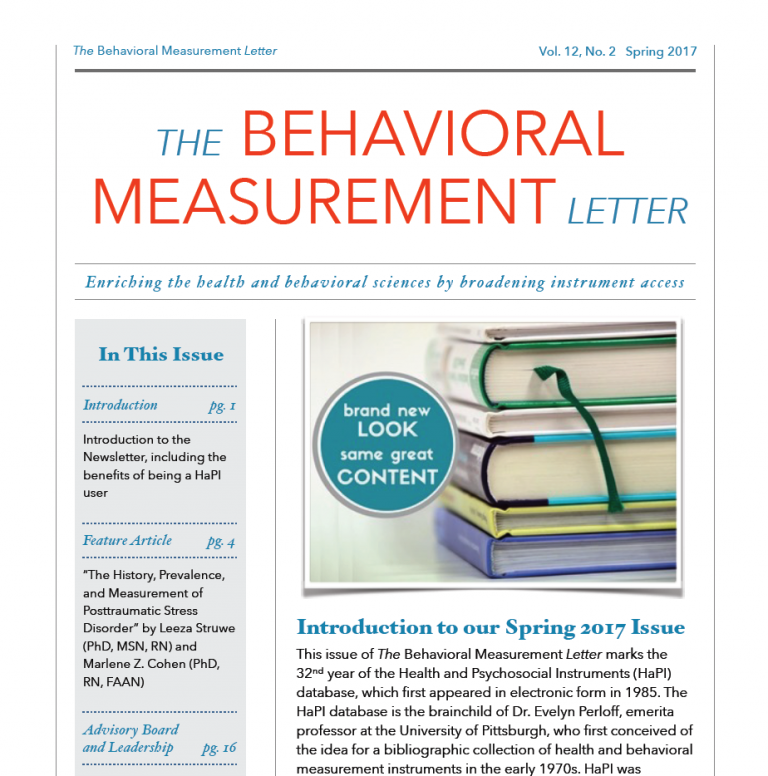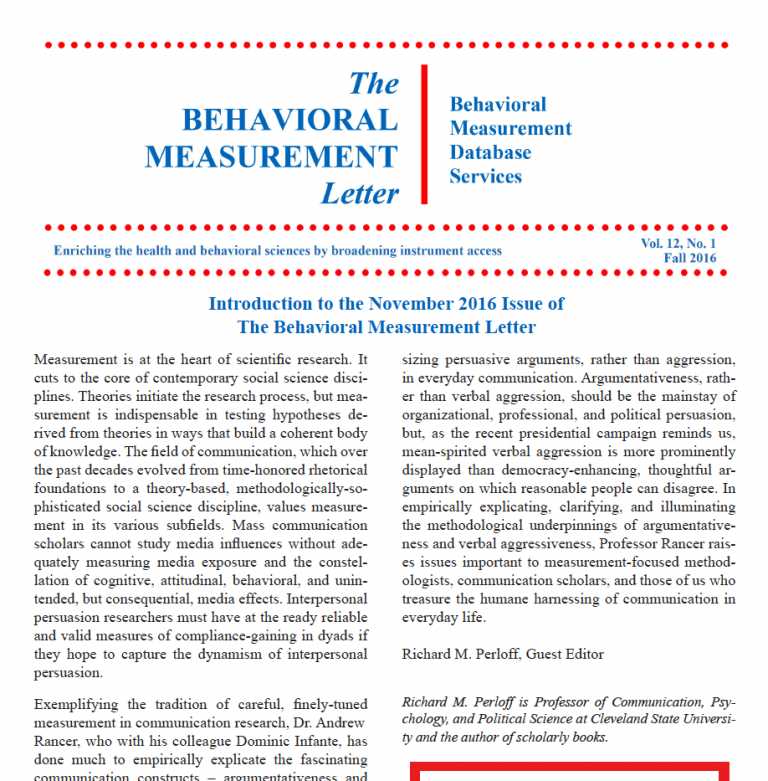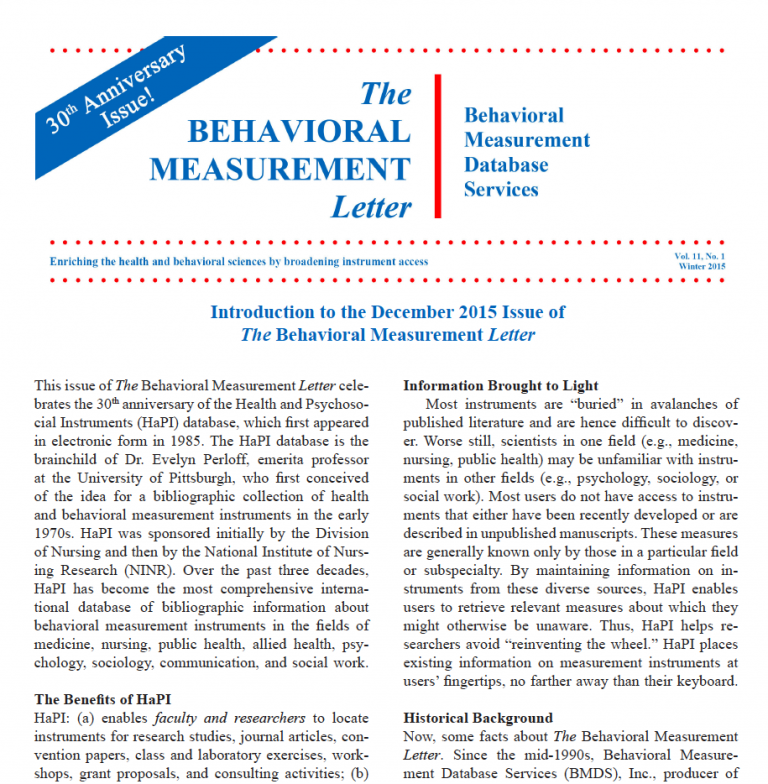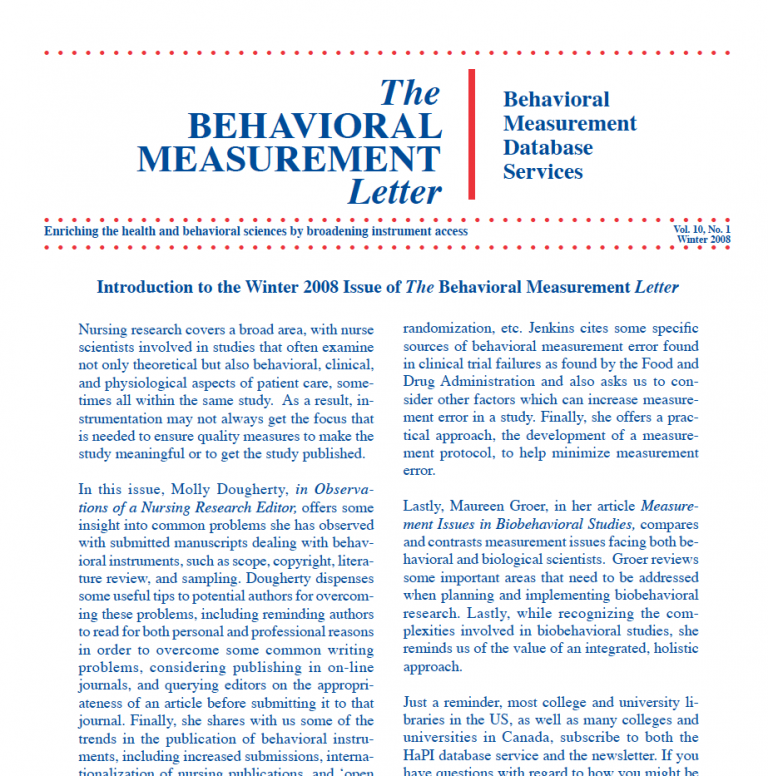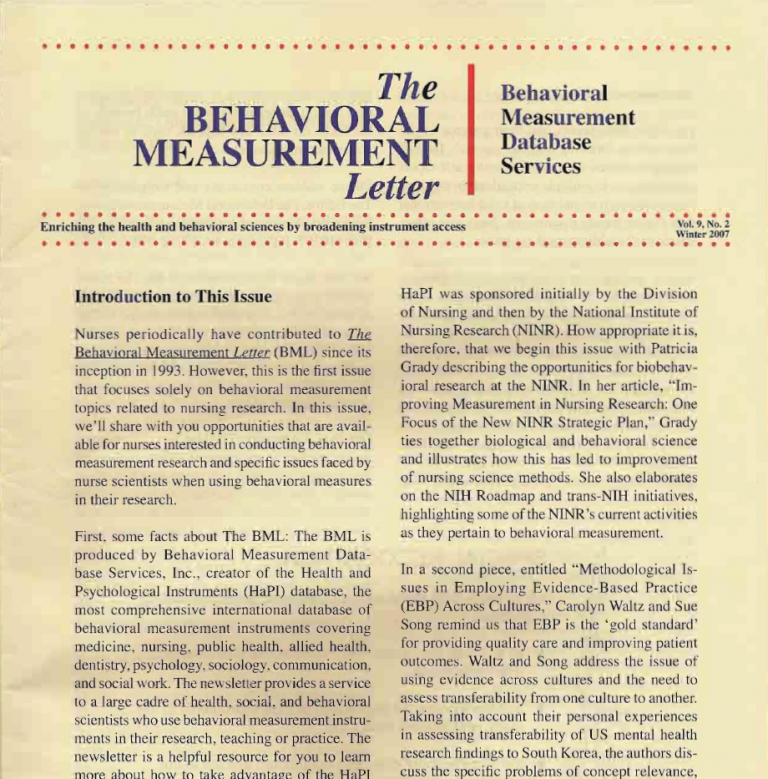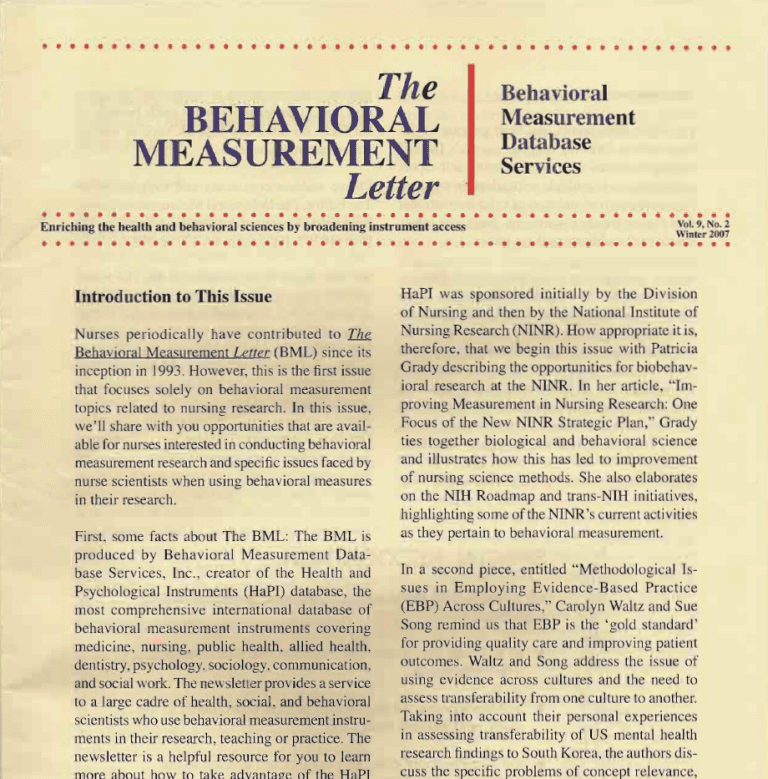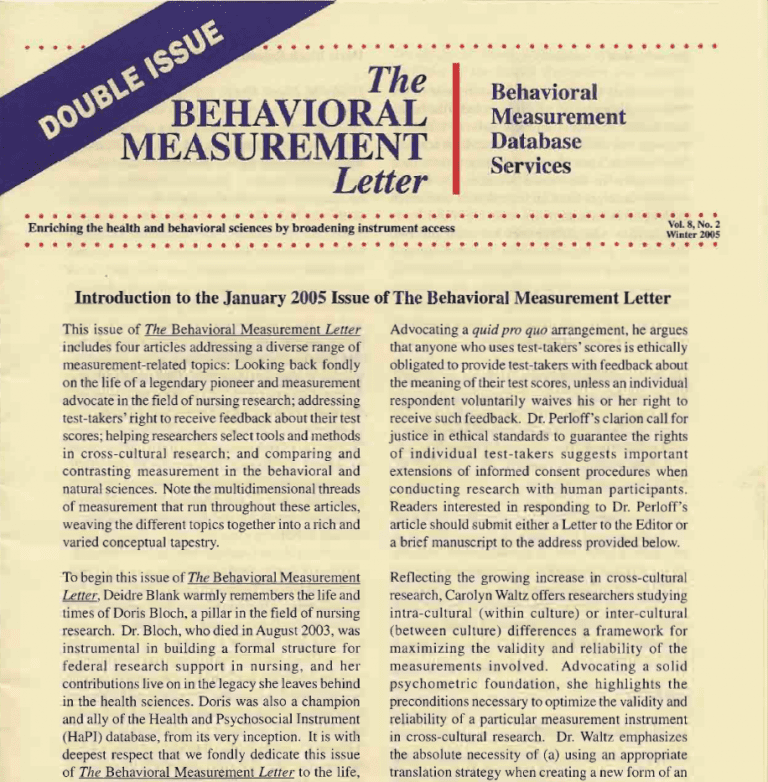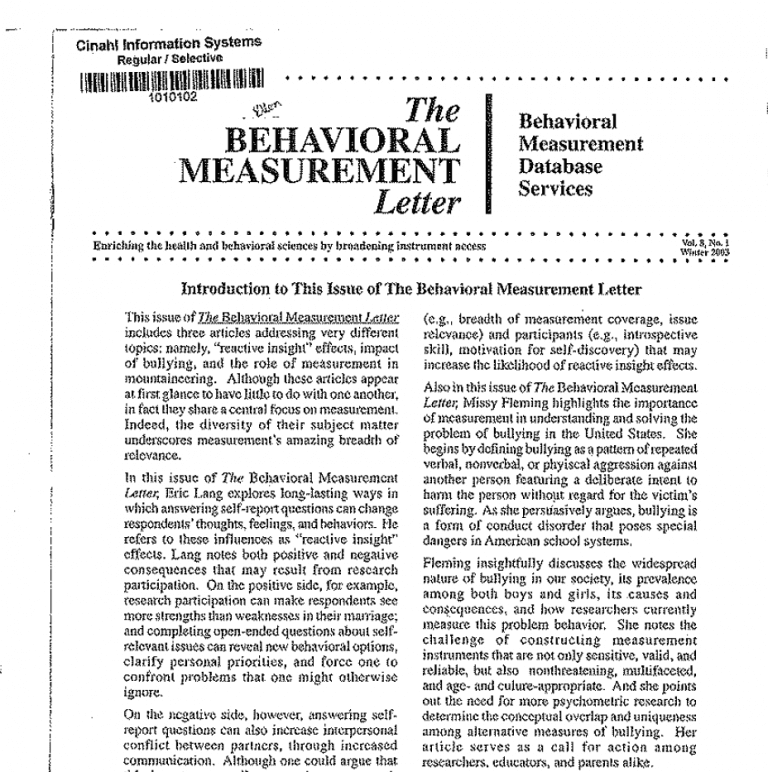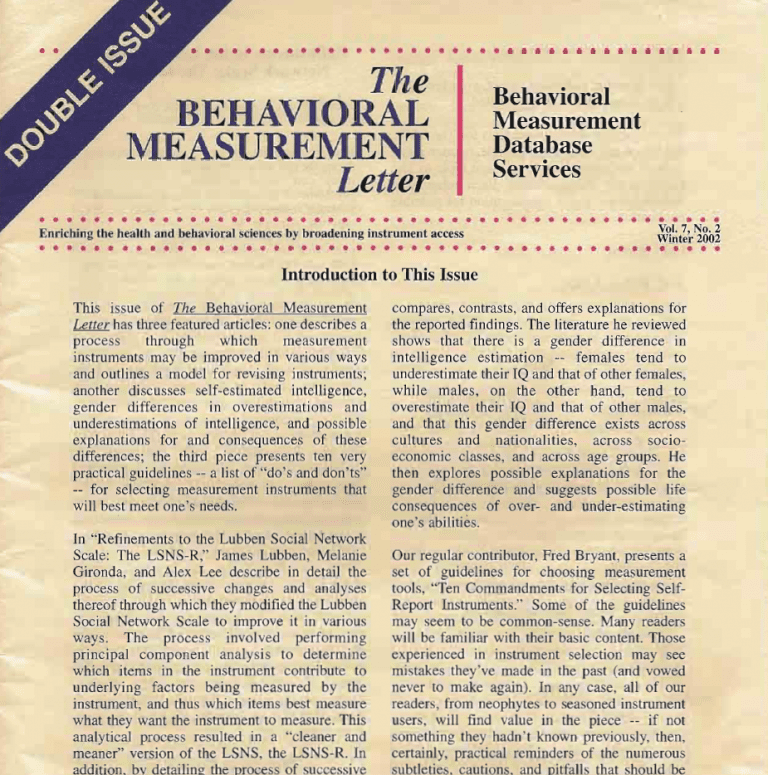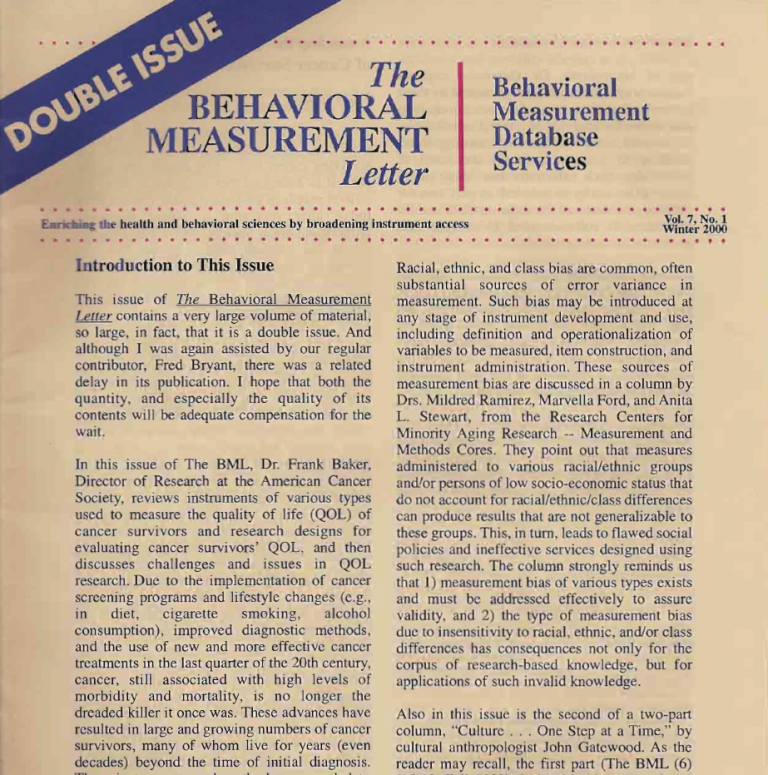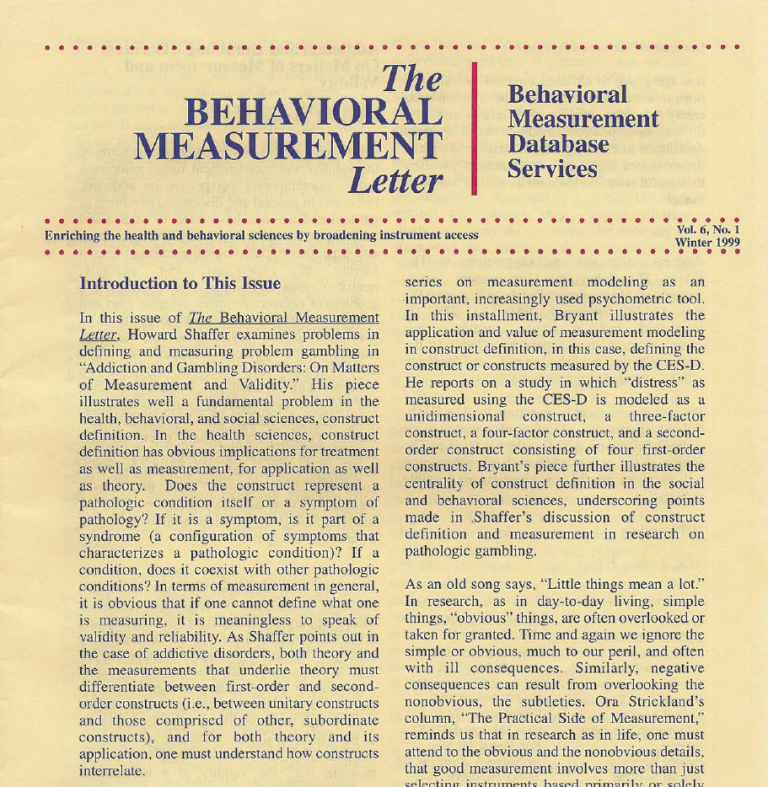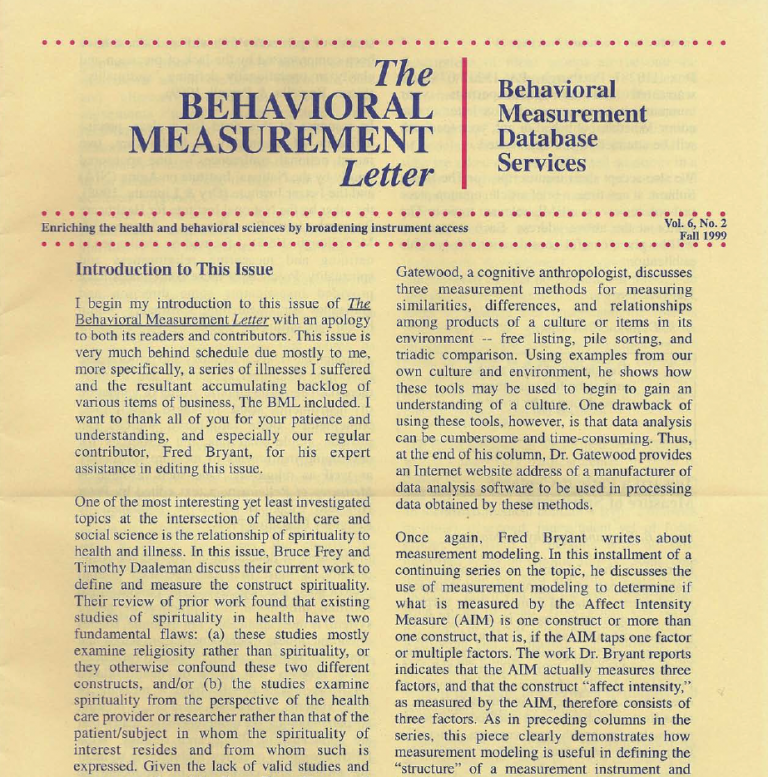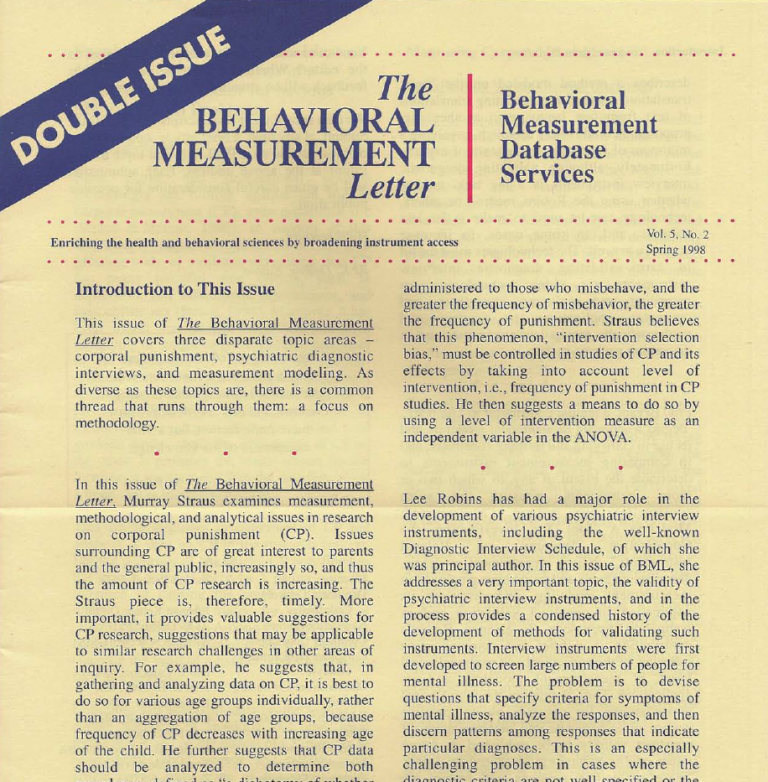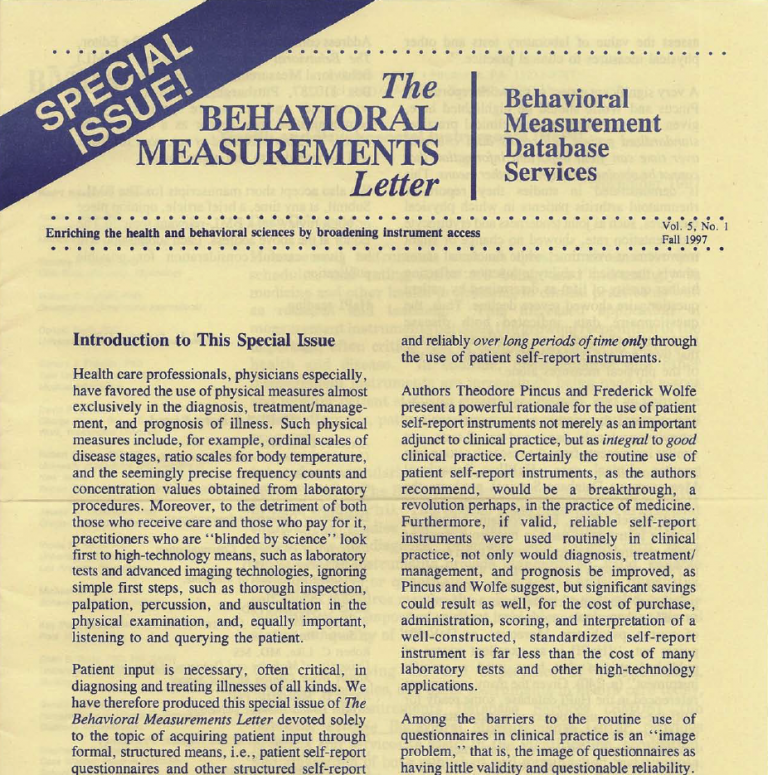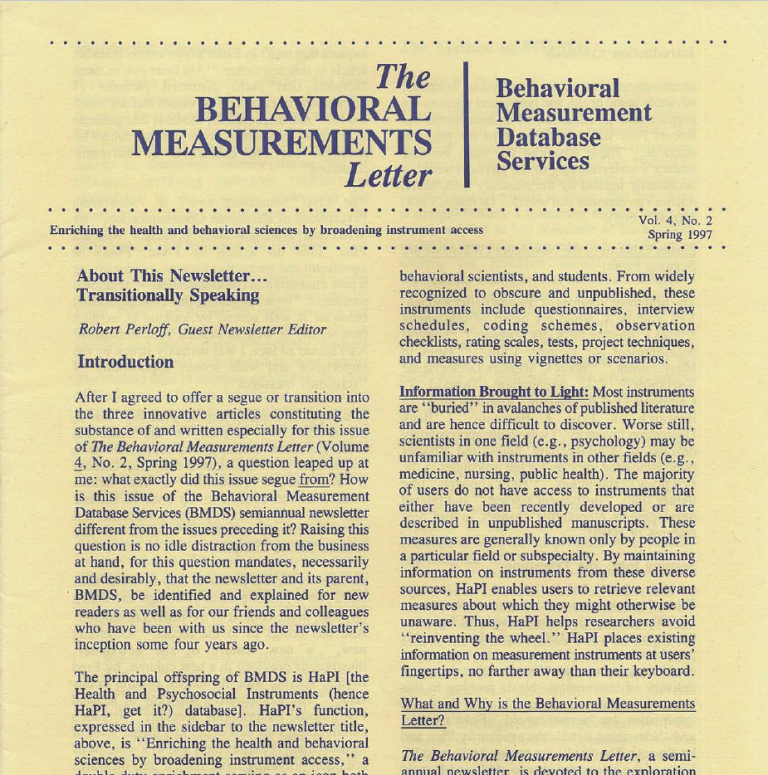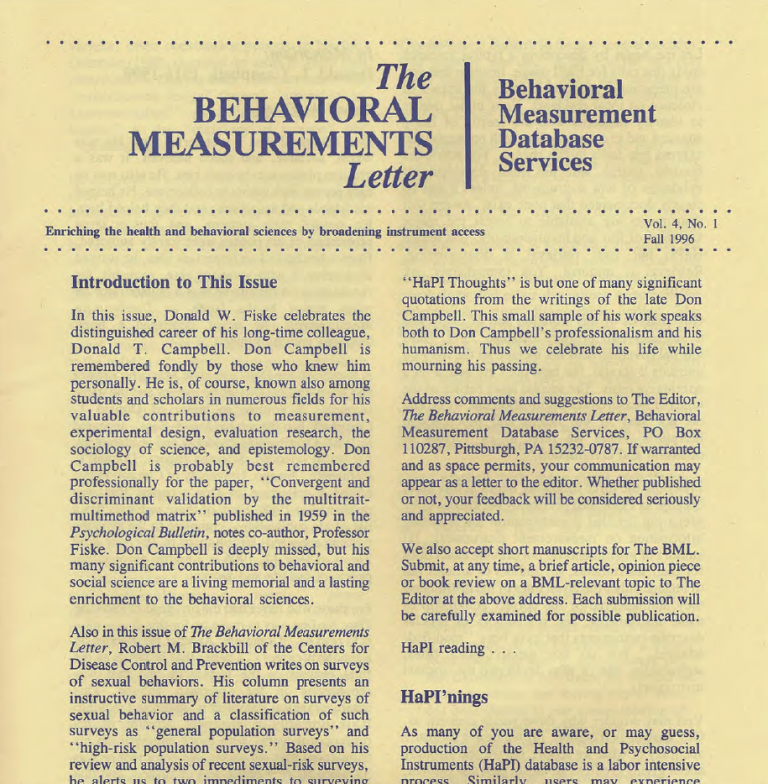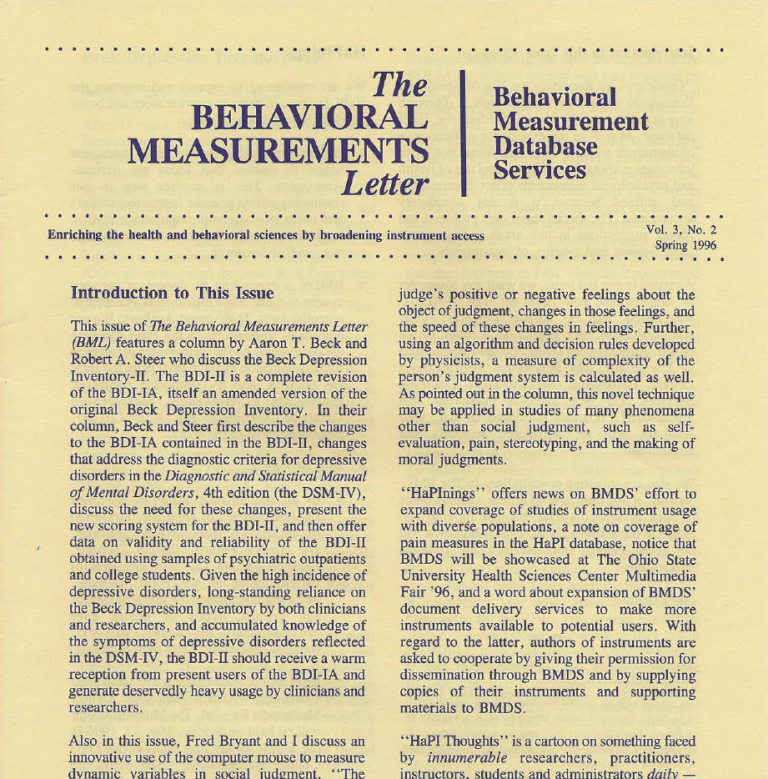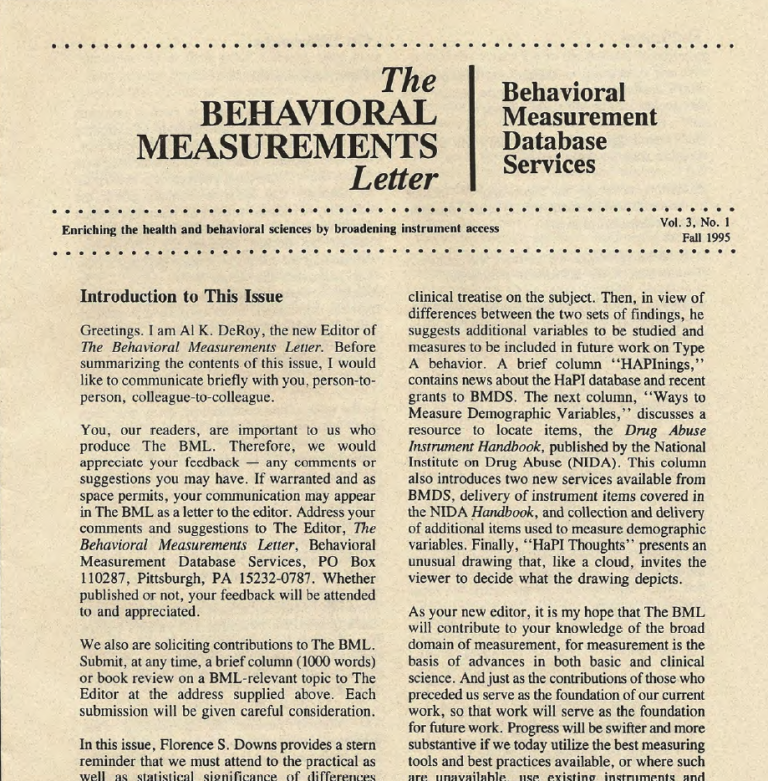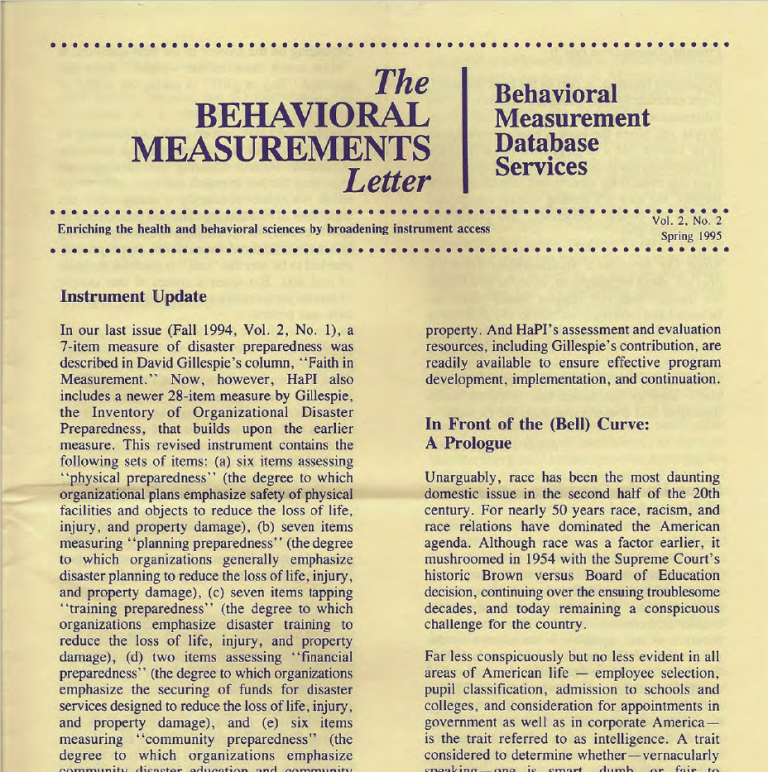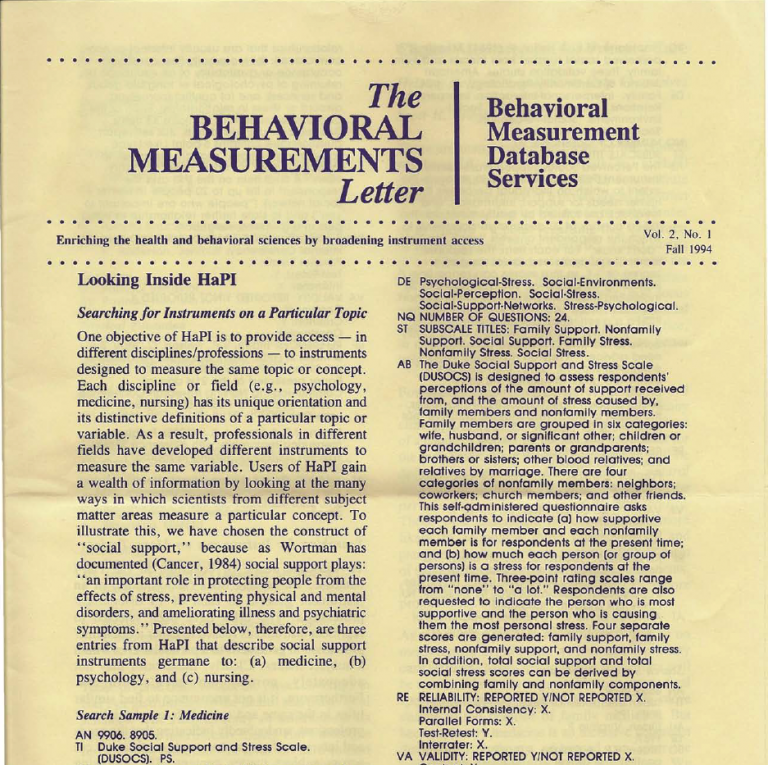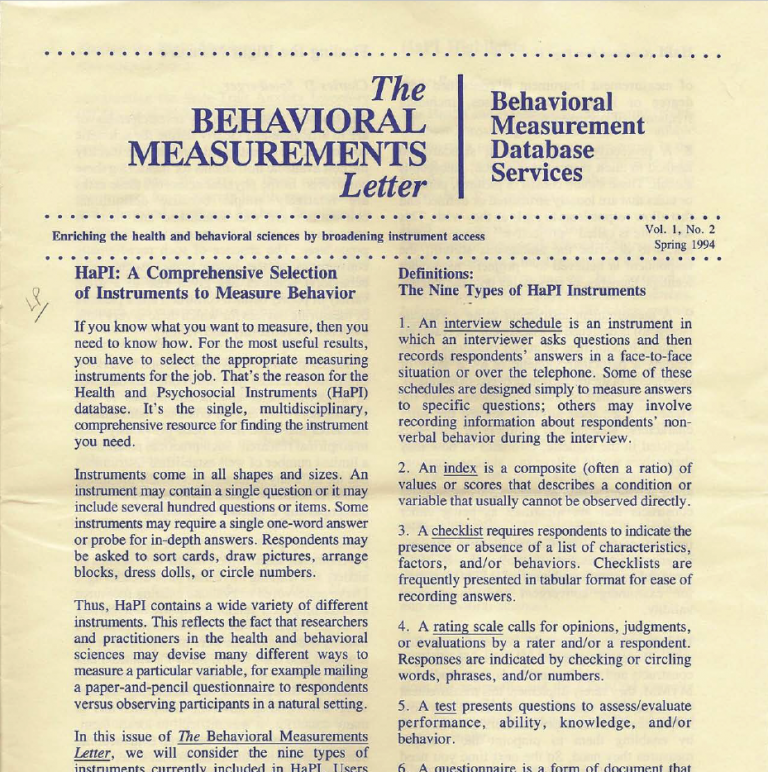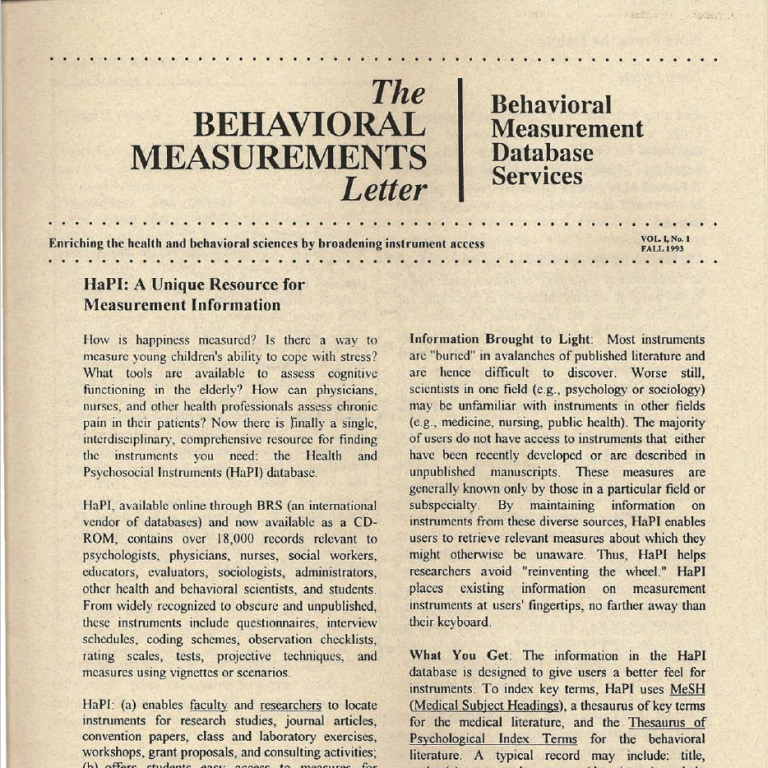Vol. 7, No.1 – Winter 2002
This issue of The Behavioral Measurement Letter contains a very large volume of material, so large, in fact, that it is a double issue. And although I was again assisted by our regular contributor, Fred Bryant, there was a related delay in its publication. I hope that both the quantity, and especially the quality of its contents will be adequate compensation for the wait.
In this issue of The BML, Dr. Frank Baker, Director of Research at the American Cancer Society, reviews instruments of various types used to measure the quality of life (QOL) of cancer survivors and research designs for evaluating cancer survivors’ QOL, and then discusses challenges and issues in QOL research. Due to the implementation of cancer screening programs and lifestyle changes (e.g., in diet, cigarette smoking, alcohol consumption), improved diagnostic methods, and the use of new and more effective cancer treatments in the last quarter of the 20th century, cancer, still associated with high levels of morbidity and mortality, is no longer the dreaded killer it once was. These advances have resulted in large and growing numbers of cancer survivors, many of whom live for years (even decades) beyond the time of initial diagnosis. Thus, instruments and methods are needed to assess the quality of life of cancer survivors in order to obtain baseline measures, to identify factors that contribute to a good QOL and those that contribute to a poor QOL for survivors, to design and improve ways and means for QOL enhancement, and to determine the effectiveness of attempts to improve cancer survivors’ QOL.
Racial, ethnic, and class bias are common, often substantial sources of error variance in measurement. Such bias may be introduced at any stage of instrument development and use, including definition and operationalization of variables to be measured, item construction, and instrument administration. These sources of measurement bias are discussed in a column by Drs. Mildred Ramirez, Marvella Ford, and Anita L. Stewart, from the Research Centers for Minority Aging Research — Measurement and Methods Cores. They point out that measures administered to various racial/ethnic groups and/or persons of low socio-economic status that do not account for racial/ethnic/class differences can produce results that are not generalizable to these groups. This, in turn, leads to flawed social policies and ineffective services designed using such research. The column strongly reminds us that 1) measurement bias of various types exists and must be addressed effectively to assure validity, and 2) the type of measurement bias due to insensitivity to racial, ethnic, and/or class differences has consequences not only for the corpus of research-based knowledge, but for applications of such invalid knowledge.
Also in this issue is the second of a two-part column, “Culture . . . One Step at a Time,” by cultural anthropologist John Gatewood. As the reader may recall, the first part (The BML (6) 2:5-10, Fall 1999) dealt with means to gain an understanding of a culture by learning how persons within the culture view their world. He presented three methods to discover how persons see similarities, differences, and relationships among products of a culture or items in its environment — free listing, pile sorting, and triadic comparison. In the second part of his column, Dr. Gatewood explores various ways to analyze data generated by these methods. Each is a type of consensus analysis and allows for analyses of either 1) similarities, differences, and relationships among items familiar to a culture, or 2) the level of knowledge each informant has about these items. (The reader is referred to part one for detailed discussion of the three methods and for references to software used to analyze data generated by these methods.)
Address comments and suggestions to The Editor, The Behavioral Measurement Letter, Behavioral Measurement Database Services, PO Box 110287, Pittsburgh, PA 15232-0787. If warranted and as space permits, your communication may appear as a letter to the editor. Whether published or not, your feedback will be attended to and appreciated.
We also accept short manuscripts for The BML. Submit, at any time, a brief article, opinion piece or book review on a BML-relevant topic to The Editor at the above address. Each submission will be given careful consideration for possible publication.
HaPI reading…
Al K. DeRoy, Editor
Assessing the Quality of Life of Cancer Survivors
Frank Baker
As a result of improvements in prevention, early detection, and treatment, more people are surviving cancer today than at any time in the past. It is estimated that there are at least 8.4 million people in the United States who are alive today after receiving a cancer diagnosis (American Cancer Society, 2000). The image of cancer has changed from a disease that was viewed as synonymous with death, to that of a chronic illness that can be survived but can inherently change various aspects of the life of the person who has the disease.
Even the definition of who is considered a cancer survivor has changed in recent years. The traditional definition of a cancer survivor was someone who was alive five years after diagnosis and was disease-free (Friedman, 1980). This definition of five-year survival was used because for many types of cancer, if a patient survives for five years, it is likely that he or she is cured. With the development of the Office of Survivorship at the National Cancer Institute, a new definition was offered that defined cancer survivors as people who were living two years postdiagnosis (Meadows et al., 1998). The American Cancer Society (ACS) has offered a definition of survivorship that is more inclusive, i.e., cancer survival begins with diagnosis and continues for the balance of the person’s life (H. Eyre, personal communication, April 24, 2000).
Cancer survivors have been described as going through a series of stages of survival (Mullan, 1985). First is an acute stage that begins at diagnosis and continues through the initial courses of medical treatment. At this stage, the survivor is commonly called a patient, and the primary focus is on physical survival. This period is followed by an extended, or intermediate, stage of survival in which survivors monitor their bodies for recurrence of disease. In this stage of recovery, quality of life becomes a major concern as survivors deal with the physical and emotional effects of treatment and their reentry into social roles. Most of the behavioral and psychosocial research with adult survivors has focused on the initial stage, when patients are in active treatment, and to some lesser extent on the second stage, when patients are likely to be seen at university-related hospitals and cancer centers where there is grant support for this kind of research.
The third major stage is called sustained remission, or long-term survival. Some long- term cancer survivors will do well. Others, however, must deal with chronic and late effects of treatment that is often toxic, that produces debilitating symptoms and impaired functioning, and that leads to short- and long- term changes in an individual’s ability to conduct a “normal” life. Thus, ever-improving technology and new treatments are saving cancer patients’ lives but at the same time have side effects and toxicities that can radically affect the quality of their lives.
Traditionally, medical evaluation of cancer treatment outcomes included tumor response, disease-free survival, and overall survival (US Department of Health and Human Services/ Public Health Service/National Institutes of Health, 1990). As length of survival increased, however, the value of cancer treatments began to be judged not only by which treatments contributed to increased survival, but also to the quality of survivors’ lives. This new criterion was called “quality of life” (QOL), a term that received its own heading in Index Medicus in 1977 (Frank-Stromborg, 1984). Quality-of-life research has increased dramatically in recent years, and there are numerous examples of activities on the national and international levels that indicate growing recognition of the importance of including QOL in assessments of patient outcomes. For example, the United States Food and Drug Administration uses QOL measurements in the process of approving drugs for the treatment of cancer (Johnson & Temple, 1985), and the National Cancer Institute includes assessments of QOL in endpoint evaluations of cancer clinical trials (Moinpour et al., 1989). The American Cancer Society (ACS) has set national challenge goals for 2015 that include improving the quality of life of cancer survivors in addition to decreasing cancer incidence and mortality (Beyers et al., 1999).
Assessing Cancer Patient’s Quality of Life
Early attempts to assess a cancer patient’s quality of life were based on ratings by doctors or other caregivers of the patient’s ability to function without special assistance. One of the first of these was the Karnofsky Performance Status Scale, which provides a rating of cancer patients’ physical functioning on a scale from 0% to 100% (moribund – normal) in increments of 10 (Karnofsky & Burchenal, 1949). Although this global clinician rating has been used widely by cooperative groups involved in clinical trials because it shows correlations with tumor response and survival, studies have shown that it has low interrater reliability and that such clinician-based ratings correlate poorly with patients’ ratings (Aaronson, 1990).
Over the last several decades, the view that the patient should be the primary source of information regarding his or her quality of life has gained general acceptance (Aaronson, Beckmann, Bernheim, & Zittoun, 1987; Celia & Tulsky, 1990). The trend toward using cancer patient self-report was furthered by studies that demonstrated that proxy ratings, whether by health care providers or family members, showed little agreement with patients’ ratings and with each other as well (Epstein, Hall, Tognetti, Son, & Conant, 1989; Osoba, 1994). When physicians are used as the source of quality-of-life ratings, they tend to emphasize physiological data and focus on symptoms and physical functioning, whereas nurses, social workers, and family members tend to emphasize psychosocial dimensions (Schipper, 1990). However, no matter who is used as a proxy for the patient, they tend to produce ratings that underestimate the QOL of patients as rated by the patients themselves (Sprangers & Aaronson, 1992). Indeed, it has been suggested that one of the most important positive effects of the widespread acceptance of the quality-of-life concept in medical practice has been the recognition that the perspective of the patient is as valid as that of the clinician (Leplege & Hunt, 1997).
While no universally accepted definition for QOL has developed over time, a general consensus has grown that quality of life is best defined as a complex multidimensional construct, not just in terms of a single dimension such as level of physical functioning (Donovan, Sanson-Fisher, & Redman, 1989; Grant et al., 1992). The World Health Organization defines quality of life as “individuals’ perceptions of their position in the context of the culture and value system in which they live and in relation to their goals, standards, and concerns” (World Health Organization-Division of Mental Health, 1993). Six broad domains are included in their definition: physical health, psychological state, levels of independence, social relationships, environmental features, and spiritual concerns. Researchers focusing on cancer survivors have developed some consensus about a minimum of four dimensions to include in quality-of-life measures: physical functioning, emotional and psychological functioning, social functioning, and disease/ treatment-related symptoms (Aaronson, 1990; Moinpour, Hayden, Thompson, Feigl, & Metch, 1990; Ganz, 1994). In addition, a global measure of perceived health status may enhance QOL measurement (Haberman & Bush, 1998).
Two approaches have been employed in attempts to define operationally the multiple dimensions of quality of life. One approach focuses on developing a single multi-dimensional scale, while a second approach is to develop many separate scales to measure QOL. The second approach may involve using a battery of single-domain scales to assess QOL, or a combination of a multidimensional measure with one or more scales that measure other domains. Instruments developed using the first approach often include generic mental health measures of such variables as depression, anxiety, mood state, self-esteem, perceived meaningfulness of life, and the like. In most cases, these measures have been normed with populations other than cancer patients, such as college students and outpatient psychiatric patients, and thus little or no information is available on how well they measure QOL of cancer patients. To overcome these limitations, normative data, especially data on validity and reliability, have been developed for some measures based on their administration to groups of cancer patients.
There have also been attempts to deal with these limitations by developing cancer-specific and diagnosis-specific QOL measures. While there is little theoretical basis for deciding what to include in a cancer-specific measure of QOL, most include measures of the key dimensions of physical well-being and associated symptoms, of psychological well-being, and measures of social well-being (Cella & Tulsky, 1993). Some researchers, too, argue for the inclusion of spirituality as a core dimension of QOL, pointing out that in interviews concerning quality of life, cancer survivors often emphasize the role of spirituality (Ferrell, Grant, Padilla, & Vemuri, 1991). In this regard, specific tools for measuring the spiritual well being of cancer patients are being developed, and evidence of a strong relationship of spirituality to QOL has been reported recently (Brady, Peterman, Fitchett, Mo, & Cella, 1999).
As interest in the assessment of quality-of-life treatment outcomes for cancer and other chronic diseases grew, some existing generic measures of health status outcomes were used initially. They were called measures of “health-related” quality of life (HRQOL), even though they had not originally been developed as QOL measures. These generic HRQOL measures include: the Sickness Impact Profile (SIP; Bergner, Bobbitt, Carter, & Gilson, 1981), which covers a wide range of functioning and focuses on behaviors rather than subjective expressions; the Medical Outcomes Study Short Form-36 (MOS SF-36; Stewart, Hays, & Ware, 1988), which consistently distinguishes among groups of patients differing in severity of illness; and the Nottingham Health Profile (NHP; Hunt, McKenna, McEwen, Williams, & Papp, 1981), which has most widely been used in the UK. It should be noted here that although the NHP is less precise in detecting distress associated with mild illness than the other generic HRQOL measures, it seems to assess adequately differences between groups with moderately severe to severe illness.
While generic measures are commonly used to assess outcomes in other chronic diseases, there has been significant focus on developing disease-specific measures for cancer outcomes. For example, quality-of-life research on the effects of cardiovascular disease has generally relied on generic measures, with some dimension-specific measures included as part of a “battery-of-measures approach” in which multiple distinct instruments are used, each measuring a specific QOL domain and each being scored separately (National Institutes of Health/National Heart Lung & Blood Institute, 1995). Additionally, since cancer is actually a number of diseases affecting different sites in the body, there has been a further refinement of cancer QOL measures to develop site-specific scales as well.
Measures of Quality of Life of Cancer Patients
Among the measures of quality of life developed specifically to use with cancer patients that have been shown to have adequate reliability and validity are the Cancer Rehabilitation Evaluation System (CARES; Schag, Heinrich, Aadland, & Ganz, 1990), the European Organization for Research and Treatment of Cancer Quality of Life Questionnaire (EORTC-QLQ-C30, Aaronson et al., 1993), the Functional Assessment of Cancer Therapy (FACT; Cella, et al., 1993), the Functional Living Index-Cancer (FLIC; Schipper, Clinch, McMurray, & Levitt, 1984), the Satisfaction with Life Domains Scale for Cancer (SLDS-C; Baker, Curbow, & Wingard, 1992), and the Spitzer Quality of Life Index (SQOL-Index; Spitzer et al., 1981). The original CARES included 139 problems that might be encountered by cancer patients on a daily basis as they attempted to cope with their disease and its treatment. A shorter form consisting of 59 items has been developed, the Cancer Rehabilitation Evaluation System-Short Form (CARES-SF; Schag, Ganz, & Heinrich, 1991). Unlike some of the other QOL measures for cancer, both forms of the CARES require permission for use and payment of fees, which may have limited their use. The European Organization for Research and Treatment of Cancer (EORTC), which involves 15 countries in one of the oldest and largest cancer clinical trials groups in Europe, developed the QLQ-C30 as a core instrument to which diagnosis-specific questionnaire modules could be added. The EORTC QLQ-C30 was developed specifically for assessment of the QOL of cancer patients participating in multinational clinical trials and has numerous parallel language versions. The FLIC and the Spitzer SQOL-Index currently appear not to be as popular as when they were first developed in the 1980s. The SLDS-C, consisting of only 17 items and employing a “smiley-frowney” faces response format to assess different life domains, has been shown to be a relatively less burdensome cancer QOL measure for patients to complete (Baker, Jodrey, Zabora, Douglas, & Fernandez-Kelly, 1996). The FACT-G, a general version of The Functional Assessment of Cancer Therapy scale that can be used with patients of any tumor type, has gone through four revisions (Cella, 1997). Disease-specific versions of the FACT have been developed for many of the major types of cancer (i.e., breast, bladder, colorectal, head and neck, lung, ovarian, and prostate), as well as for HIV infection, by adding items specifically relevant to different cancer sites to the core set of items in the FACT-G (Kornblith & Holland, 1994).
Several measures have been developed to evaluate the unique quality-of-life outcomes of bone marrow transplantation, a particularly demanding cancer treatment. Among these are the Quality of Life Scale-Bone Marrow Transplant, developed at the City of Hope by Ferrell and Grant (Ferrell et al., 1992; Grant et al., 1992), the Cella FACT-BMT (McQuellon et al., 1997), and the Bush Bone Marrow Transplant Symptom Inventory (Bush, Haberman, & Donaldson, 1995; Bush & Langer, 1998).
Research Designs for Evaluating Quality of Life
The most commonly used research designs in psychosocial and behavioral research on cancer have been cross-sectional in nature. Cross-sectional assessments are useful for describing the current effects that survivors are experiencing at a particular point in time in relation to other variables assessed at that time. However, this type of design has several noteworthy deficiencies. Retrospective reports are of only limited reliability regarding the respondents’ perceived quality of life at an earlier time, such as at the time of treatment or before cancer diagnosis. Retrospective assessments performed years after treatment also have a selection bias in that only those who survived to that time are available to be asked about their experience of the disease and its treatment, while there is no comparable data on those who died.
Clinical trials involve random assignment into groups exposed to an intervention and groups not exposed, and the collection of data before and after exposure to the intervention. With the heightened attention being given to QOL effects of new treatments, QOL measures that are sensitive to change have become of particular interest to pharmaceutical companies for use in clinical trials of drug effectiveness. Unfortunately, these trials may not show the positive QOL effects that are hoped for because of lack of attention to, or understanding of, the psychometric characteristics of particular measures or what dimensions they include. Another limitation to the research designs that have been used traditionally to evaluate quality of life of cancer patients is their predominant dependence on relatively small opportunistic samples of patients from large cancer treatment centers. These samples have usually had little diversity, tending to exclude racial/ethnic minority group members, individuals from rural areas, and people of lower socio-economic status.
The use of prospective, population-based, longitudinal designs with representative samples of people diagnosed with different types of cancer selected by using state cancer registries as a sampling frame offers a way of overcoming a number of these deficiencies.
Cross-Cultural Health-Related Quality-of-Life Instruments
Over the last decade, interest has grown significantly in developing measures that can be used to compare quality of life in different countries, cultures, and languages (Anderson, Aaronson, Bullinger, & McBee, 1996). This has been further stimulated by the trend toward multinational pharmaceutical trials that require measuring the same constructs cross-culturally with the same degree of precision to permit pooling data from different countries for analysis.
In the United States, as clinical trials funded by the National Institutes of Health required the inclusion of minorities wherever possible, it was found that quality-of-life measures that had been developed using White middle-class populations appeared to be difficult for poor and minority populations to respond to and that these measures did not seem to be culturally relevant for some groups (Baker et al., 1996). The National Cancer Institute therefore funded a number of research projects to develop measures that were appropriate for minorities and lower socioeconomic groups (e.g., Warnecke et al., 1996). In a study that sought to test the cultural equivalence of QOL instruments that might be used with Hispanic and African American cancer patients, it was found that the measures that seemed most appropriate for these groups used simple, often graphic, response formats (Baker et al., 1996). For Hispanic populations, the most successful technique involved translation into Spanish and back-translation into English by individuals who spoke the varieties of Spanish associated with subjects’ different countries of origin. Some quality-of-life measures turned out not to be culturally relevant or acceptable to some minority groups. For those with limited literacy, it was found that a brief pretest to determine level of literacy was useful, and that administrating the QOL measures through an interview was desirable.
Quality-of-Life Measures for Children
Unlike adult cancer survivors who have been studied for the most part with cross-sectional research designs, child survivors have been followed in long-term longitudinal studies. Until recently, however, quality-of-life research with pediatric cancer survivors has been limited by the fact that most quality-of-life measures were designed for adults and were not appropriate for children. Thus, instead, parents or health care providers were asked to report on children’s quality of life (Bradlyn et al., 1996). As noted above, however, proxy assessments of a patient’s quality of life rarely agree with the patient’s self-report. Thus, in recent years, a serious commitment has been made to developing measures that are based on qualitative explorations of the pediatric perspective and that are developmentally appropriate. As a result, creative formats for self-report measures are being called for in assessing the QOL of children and adolescents (Hinds & Haase, 1998). Although visual analog scales and other graphic formats, for example, have increased the choice of methods for presenting questions, developing games and interactive videos to ask questions about QOL might better maintain children’s motivation and willingness to respond to the same items repeatedly over months or years.
Some of the same problems in quality-of-life assessment of persons with low literacy are also encountered with children, and some of the same solutions are appropriate for use with children. As noted above, until just a few years ago, assessment of quality of life for childhood cancer patients was dependent on the responses of their parents or caregivers. Proxy respondents were used even for older children able to read and understand items developed for adults. In recent years, these “adult-normed” measures are adding normative data developed for teen-age and young adults populations. Moreover, as mentioned above, innovative techniques using presentation formats appropriate for young children are being developed as well.
Respondent Burden
A constraint on what and how many QOL instruments to use is the issue of respondent burden. Cancer patients must deal with significant fatigue, nausea, pain, and other symptoms that make it difficult for them to complete long, burdensome questionnaires and/or interviews. But reliability and sensitivity to change are usually enhanced as instrument length increases. Also, covering multiple dimensions of quality of life usually requires use of multiple scales or measures, either in one instrument or as a battery. In addition, in order to track changes in quality of life over time, a measure must be repeated over time. Thus, in assessing the QOL of cancer patients, researchers and clinicians often must struggle to gain a reasonable balance between maximizing coverage, reliability and sensitivity on the one hand, and minimizing respondent burden on the other.
Furthermore, respondents may become frustrated with having to answer the same or similar questions repeatedly. Ordering the presentation of questions logically seems helpful, as does labeling each section of the instrument. Grouping scales that have similar response formats may also be helpful, since patient respondents may become irritated with shifting among response formats employed in different scales. Patients also complain about the changing time periods that different scales use — a week, two weeks, a month, six months, a year, and so forth, as well as shifting back and forth across formats. Pilot-testing a questionnaire or interview with a few representative patients is critical to resolving these issues.
Asking a cancer patient to respond to questions about various aspects of their life is not, however, all burden. Often patients say that they appreciate the researcher’s interest in their personal experience and in having an opportunity to describe any QOL problems that they may be facing. Some patients have described the experience of responding to QOL questions as having a therapeutic effect that helps them place their experiences in perspective and broadens their consideration of what is happening to them and their families. Responding to questions about their lives seems to have healing effects, which have been described in relation to the “healing power” of telling one’s story, by providing cognitive, affective, interpersonal, and personal growth benefits (Heiney, 1995).
Some relatively short instruments only take two or three minutes to complete. One of these is Cantril’s Self-Anchoring Ladder of Life [Self- Striving Scale], which was designed to measure a general sense of well-being (Cantril, 1965). This measure, which uses a simple graphic response format, has high content validity as well as face validity. Respondents are presented with a picture of a 10-rung ladder with the highest rung marked “10” and the lowest rung marked “1”. They are then asked to indicate where they would place themselves now, some specific time in the past, and some time in the future in terms of their satisfaction with their lives. This approach has been used successfully in assessing well-being with cancer patients undergoing bone marrow transplantation (Baker, Curbow, & Wingard, 1991; Baker, Zabora, Jodrey, Polland, & Marcellus, 1995) and with patients receiving other treatments (Ashing-Giwa & Ganz, 1997; Visser & Smets, 1998).
Quality-of-Life Surveillance
There has been growing recognition by the public health community that a focus on biomedically-oriented measures of a population’s well-being, such as mortality and morbidity, provides an inadequate picture of the outcomes of prevention and treatment, and that additional measures are needed. For example, both the earlier “Healthy People 2000” and the updated goals for the nation in “Healthy People 2010” include not only goals to prevent premature death, disability, and disease, but also goals concerning enhancement of the quality of life. Population-focused goals such as these pose unique challenges for QOL assessments, which have tended to be limited to collecting data from opportunistic samples of people.
Increasingly progress is being made in including QOL measures in large population-based studies. In 1993, measures of health-related quality of life (HRQOL) were introduced into the Centers for Disease Control and Prevention’s Behavioral Risk Factor Surveillance System (BRFSS), which uses telephone surveys to monitor health risk behaviors among adults (Centers for Disease Control and Prevention, 1995). Four general questions are included: (a) ratings of the respondent’s health from “excellent” to “poor”; (b) how many days during the previous 30 days the respondent’s physical health was not good because of injury or illness; (c) how many days during the previous 30 days their mental health was not good because of stress, depression, or “problems with emotions”; and (d) how many days during the previous 30 days their physical or mental health prevented them from performing usual activities, such as self-care, work, or recreation. Since 1995, state health departments have had the option of including an expanded set of 14 HRQOL questions in the BRFSS.
As noted above, the ACS, which has set goals for improving the quality of life of cancer survivors by the year 2015, is developing a nation-wide longitudinal, prospective study that is seeking to enroll a population-based sample of tens of thousands of cancer survivors to determine their changing quality of life and needs for services (Denniston, Brogan, Baker, Dye, & Hann, 1999). In this ACS study, a battery of quality-of-life measures is being employed in questionnaire surveys, repeated over a ten-year period, of people who survive one of the ten most common cancers.
The ACS is also conducting secondary analyses of data available from existing national surveys to provide a baseline assessment of the current quality of life of cancer survivors and to determine how the ACS can best allocate its resources to meet the goal of improving the QOL of cancer survivors. Data from the 1998 Health Care Financing Administration’s (HCFA’s) Medicare Health Outcomes Survey (MHOS) of people enrolled in managed care services through Medicare were analyzed to provide baseline estimates of quality of life of cancer survivors in comparison to a matched cohort of respondents who had not suffered cancer. The HOS was mailed to a random sample of 1,000 Medicare beneficiaries continuously enrolled for six months in a plan with a Medicare contract in place on or before January 1, 1997. In plans with 1,000 or fewer Medicare enrollees, all eligible members were surveyed. The 1998 data collection included 279,135 beneficiaries enrolled in 268 managed care plans covering 287 market areas. Completed surveys were received from 167,096 respondents for a raw response rate of 60%. An analytic data set was created that merged together plan characteristics from HCFA, administrative data files containing the survey response data, and patient demographic and entitlement information from the Medicare Enrollment Data Base. Some 23,137 respondents who answered positively when asked if a doctor had ever told them that they had any cancer other than skin cancer were age-matched to an equal number of respondents who indicated that they had not been diagnosed with cancer. Comparisons of the cancer survivors with the noncancer group indicated that the cancer survivors had significantly poorer scores on all eight of the subscales of the Medical Outcomes Study Short Form-36 (MOS SF-36; Baker, Hafter, & Denniston, 2000). Other analyses of cancer survivors’ quality of life by ACS in collaboration with HCFA are planned for the continuing HCFA surveys of the quality- of-life outcome in Medicare-contracted managed care.
Quality of Life Issues for Future Research
Scales used for assessing the quality of life of cancer patients often suffer from ceiling and floor effects. If there is no room for respondents to indicate improvement for their quality of life because respondents tend to cluster at the top scores on the scale (ceiling effect), the measure will have limited utility in assessing positive changes in QOL over repeated assessments. Similarly if the scale does not allow a respondent to indicate a decrease in quality of life because respondents tend to be clustered at the bottom of the scale with little room for downward change (floor effect), there is a question of how useful the scale can be. Both problems have been encountered in using various quality-of-life measures to assess the QOL of cancer patients. For example, the MOS SF-36 has been observed to show some floor effects in that it does not sufficiently allow the very old to indicate limits in their physical functioning. Given that cancer tends to come later in life (American Cancer Society, 2000), this poses a particular problem in assessing the QOL of longer-term survivors who may be of advanced age.
Related to ceiling effects is the common finding that cancer survivors rate their quality of life at very high levels. Some studies that have compared the responses on self-report measures of quality of life of cancer patients and normal, healthy population groups have found that the cancer patients fail to show a lower quality of life than the healthy individuals (Breetvelt & van Dam, 1991), as opposed to results from more in-depth interviews with these patients and the experience of physicians, nurses, and other caregivers with these patients. This apparent over-estimation in patient self-reporting has also been found with other patient groups. The phenomenon, termed “response-shift” by some researchers, is attributed not so much to limitations of a specific measure, but rather to a change in standard used by survivors, i.e., they are so happy to be alive that they shift the bases for their comparisons in responding to quality-of-life questions.
Psychosocial and behavioral research, including QOL research, have tended to concentrate on breast cancer for various reasons, including the facts that this type of cancer is the most common cancer in women, that it threatens an organ that is associated with psychological issues of prime importance to both sick and healthy women, and that there generally has been greater availability of funding for research on this type of cancer than others. Recently, more attention has been given to prostate and colorectal cancer, two of the other most commonly occurring types of cancer, and consequently more attention is being given to the unique QOL issues associated with these cancers and other types as well.
Given that there is no “gold standard” for quality-of-life assessment, there is a tendency toward using ad hoc measures, so it is difficult to compare results across various studies. Thus, the inclusion of QOL measures as a part of population-based surveillance of the general population is an asset to be further explored and developed. Also, increasing the number of cancer survivors in such population surveys will allow tracking of improvements associated with national efforts to improve QOL by various organizations over the next decades.
Moreover, greater efforts to develop consensus regarding the conceptualization and measurement of QOL in cancer certainly seem to be justified. These efforts should involve more participation of cancer patients and survivors in defining their QOL. Further development of conceptual and theoretical models of QOL in cancer is needed to guide research in this area. The absence of conceptual development is particularly evident in the assessment of quality of life of childhood cancer patients, survivor populations, and family members of cancer patients/survivors.
Finally, quality of life at the end of life is gaining increasing attention. This type of assessment poses unique methodological problems that require special attention. For example, given that one of the major problems of dying cancer patients is severe pain, medication to manage the pain may make it difficult or impossible to collect self-report QOL data. In these cases it may be necessary to use proxy respondents, which poses the problems noted above. It also may be necessary to identify different life concerns at the end of life, such as the patient’s needs to feel that he or she is being treated with dignity, has settled their affairs, and has resolved strained interpersonal relationships (Stewart, Teno, Patrick, & Lynn, 1999).
References
Aaronson, N.K. (1990). Quality of life research in cancer clinical trials: A need for common rules and language. Oncology, 4, 59-66.
Aaronson, N.K., Ahmedzai, S., Bergman, B., Bullinger, M., Cull, A., Duez, N.J., Filiberti, A., Flechtner, H., Fleishman, S.B., dcHaes, J.C.J.M., Kaasa, S., Klee, M., Osoba, D., Razavi, D., Rofe, P.B., Schraub, S., Sneeuw, K., Sullivan, M., & Takeda, F. (1993). European Organization for Research and Treatment of Cancer Quality of Life Questionnaire (EORTC-QLQ30). Journal of the National Cancer Institute, 85, 365-376.
Aaronson, N.K., Beckmann, J.H., Bernheim, J.L., & Zittoun, R. (Eds.). (1987). The quality of life of cancer patients. New York: Raven Press.
American Cancer Society. (2000). Cancer facts and figures, 2000. Atlanta, GA: Author.
Anderson, R.T., Aaronson, N.K., Bullinger, M., & McBee, W.L. (1996). A review of the progress towards developing health-related quality-of-life instruments for international clinical studies and outcomes research. PharmacoEconomics, 10, 336-355.
Ashing-Giwa, K., & Ganz, P.A. (1997). Understanding the breast cancer experience of African-American women. Journal of Psychosocial Oncology, 15, 19-35.
Baker, F., Curbow, B., & Wingard, J.R. (1991). Role retention and quality of life of bone marrow transplant survivors. Social Science & Medicine, 6, 697-704.
Baker, F., Curbow, B., & Wingard, J.R. (1992). Development of the Satisfaction with Life Domains Scale for Cancer. Journal of Psychosocial Oncology, 10(3), 75- 90.
Baker, F., Haffer, C., & Denniston, M. (2000, January). The health-related quality of life of cancer survivors in Medicare managed care. Washington, DC: Paper presented at the Partnerships for Health in the New Millennium: Launching Healthy People 2010 Conference.
Baker, F., Jodrey, D., Zabora, J., Douglas, C. & Fernandez-Kelly, P. (1996). Empirically selected instruments for measuring quality-of-life dimensions in culturally diverse populations. Journal of the National Cancer Institute, 20, 39-47.
Baker, F., Zabora, J., Jodrey, D., Polland, A., & Marcellus, D. (1995). Quality of life and social support of patients being evaluated for bone marrow transplantation. Journal of Clinical Psychology in Medical Settings, 2, 357-372.
Bergner, M., Bobbitt, R.A., Carter, W.B., & Gilson, B.S. (1981). The Sickness Impact Profile: Development and final revision of a health status measure. Medical Care, 19, 787-806.
Byers, T., Mouchawar, J., Marks, J., Cady, B., Lins, N., Swanson, G.M., Bal, D.G., & Eyre, H. (1999). The American Cancer Society challenge goals. How far can cancer rates decline in the US by the year 2015? Cancer, 86, 715-727.
Bradlyn, A.S., Ritchey, A.K., Harris, C.V., Moore, I.M., O’Brien, R.T., Parsons, S.K., Patterson, K., & Pollock, B.H. (1996). Quality of life research in pediatric oncology. Research methods and barriers. Cancer, 78, 1333-1339.
Brady, M.J., Peterman, A.H., Fitchett, G., Mo, M., & Cella, D. (1999). A case for including spirituality in quality of life measurement in oncology. Psycho-Oncology, 8, 417-428.
Breetvelt, I.S., & van Dam, F.S.A.M. (1991). Underreporting by cancer patients: The case of response- shift. Social Science & Medicine, 32, 981-987.
Bush, N.E., Haberman, M., & Donaldson, G. (1995). Quality of life of 125 adults surviving 6-18 years after bone marrow transplantation. Social Science & Medicine, 40, 479-490.
Bush, R.A., & Langer, R.D. (1998). The effects of insurance coverage and ethnicity on mammography utilization in a postmenopausal population. Western Journal of Medicine, 168, 236-240.
Cantril, H. (1965). The pattern of human concerns. New Brunswick, NJ: Rutgers University Press.
Cella, D.F. (1997). The Functional Assessment of Chronic Illness Therapy (FACIT) Measurement System. Evanston, IL: Center on Outcomes Research & Education (CORE), Evanston Northwestern Health Care, Northwestern University.
Cella, D.F., & Tulsky, D.S. (1990). Measuring quality of life today: Methodological aspects. Oncology, 4, 29-38.
Cella, D.F., & Tulsky, D.S. (1993). Quality of life in cancer: Definition, purpose, and method of measurement. Cancer Investigation, 11, 327-336.
Cella, D.F., Tulsky, D.S., Gray, G., Sarafian, B., Linn, E., Bonomi, A., Silberman, M., Yellen, S.B., Winicour, P., Brannon, J., & et al. (1993). The Functional Assessment of Cancer Therapy Scale. Development and validation of the general measure. Journal of Clinical Oncology, 11, 570-579.
Centers for Disease Control and Prevention. (1995). Health-related quality-of-life measures-United States, 1993. Morbidity and Mortality Weekly Report, 44, 195-200.
Denniston, M., Brogan, D., Baker, F., Dye, J.T., & Hann, D.M. (1999, August). Survey design challenges in sampling recently diagnosed cancer survivors. Paper presented at the Joint Statistical Meetings, Section on Survey Research Methods, Baltimore, MD: Joint Statistical Meetings.
Donovan, K., Sanson-Fisher, R. W., & Redman, S. (1989). Measuring quality of life in cancer patients. Journal of Clinical Oncology, 7, 959-968.
Epstein, A.M., Hall, J.A., Tognetti, J., Son, L.H., & Conant, L. (1989). Using proxies to evaluate quality of life. Medical Care, 27, 591-598.
Ferrell, B.R., Grant, M., Schmidt, G.M., Whitehead, C., Fonbuena, P., & Forman, S.J. (1992). The meaning of quality of life for bone marrow transplant survivors. Part 1: The impact of bone marrow transplant on quality of life. Cancer Nursing, 15, 153-160.
Ferrell, B.R., Grant, M., Padilla, G., & Vemuri, S. (1991). The experience of pain and perceptions of quality of life: Validation of a conceptual model. Hospice Journal, 7, 9-24.
Frank-Stromberg, M. (1984). Selecting an instrument to measure quality of life. Oncology Nursing Forum, 11, 88-91.
Friedman, G.D. (1980). Primer of epidemiology. New York: McGraw-Hill.
Ganz, P.A. (1994). Quality of life and the patient with cancer: Individual and policy complications. Cancer, 74 (Suppl. 4), 1445-1452.
Grant, M., Ferrell, B., Schmidt, G.M., Fonbuena, P., Niland, J.C., & Forman, S.J. (1992). Measurement of quality of life in bone marrow transplantation survivors. Quality of Life Research, 1, 375-384.
Haberman, M.R., & Bush, N. (1998). Quality of life: Methodological measurement issues. In C.R. King, & P.S. Hinds (Eds.), Quality of Life from nursing and patient perspectives: Theory, research, practice. Sudbury, MA: Jones and Bartlett.
Heiney, S.P. (1995). The healing power of story. Oncology Nursing Forum, 22, 899-911.
Hinds, P.S., & Haase, J.E. (1998). Quality of life in children and adolescents with cancer. In C.R. King, & P.S. Hinds (Eds.), Quality of life from nursing and patient perspectives: Theory, research, practice. (pp. 93-114). Sudbury, MA: Jones and Bartlett.
Hunt, S.M., McKenna, S.P., McEwen, J., Williams, J., & Papp, E. (1981). The Nottingham Health Profile: Subjective health status and medical consultations. Social Science & Medicine, 15A, 221-229.
Johnson, J.R., & Temple, R. (1985). Food and Drug Administration requirements for approval of new anticancer drugs. Cancer Treatment Reports, 69, 1155- 1157.
Karnofsky, D.A., & Burchenal, J. (1949). The clinical evaluation of chemotherapeutic agents in cancer. In C.M. MacLeod (Ed.), Evaluation of chemotherapeutic agents. New York: Columbia Press.
Kornblith, A.B., & Holland, J.C. (1994). Handbook of measures for psychological, social and physical functioning in cancer (Vol. 1). New York: Memorial Sloan-Kettering Cancer Center.
Leplege, A., & Hunt S. (1997). The problem of quality of life in medicine, JAMA, 278, 47-50.
McQuellon, R.P., Russell, G.B., Cella, D.F., Craven, B.L., Brady, M., Bonomi, A., & Hurd, D.D. (1997). Quality of life measurement in bone marrow transplantation: Development of the Functional Assessment of Cancer Therapy-Bone Marrow Transplant (FACT-BMT) scale. Bone Marrow Transplantation, 19, 357-368.
Meadows, A.T., Varricchio, C., Crosson, K., Harlan, L., McCormick, P., Nealon, E., Smith, M., & Ungerleider, R. (1998). Research issues in cancer survivorship. Report of a workshop sponsored by the Office of Cancer Survivorship, National Cancer Institute. Cancer Epidemiology, Biomarkers & Prevention, 7, 1145-1151.
Moinpour, C.M., Feigl, P., Metch, B., Hayden, K.A., Meyskens, F.L., Jr., & Crowley, J. (1989). Quality of life end points in cancer clinical trials. Journal of the National Cancer Institute, 81, 485-495.
Moinpour, C.M., Hayden, K.A., Thompson, I.M., Feigl, P., & Metch, B. (1990). Quality of life assessment in Southwest Oncology Group trials. Oncology, 4, 79-84, 89.
Mullan, F. (1985). Seasons of survival: Reflections of a physician with cancer. New England Journal of Medicine, 313, 270-273.
National Institutes of Health/National Heart Lung & Blood Institute. (1995) Health-related quality of life: Findings from NHLBI-supported clinical research. Bethesda, MD: US Department of Health and Human Services.
Osoba, D. (1994). Lessons learned from measuring health-related quality of life in oncology. Journal of Clinical Oncology, 12, 608-616.
Schag, C.A., Ganz, P.A., & Heinrich, R.L. (1991). Cancer Rehabilitation Evaluation System-Short Form (CARES-SF). A cancer specific rehabilitation and quality of life instrument. Cancer, 68, 1406-1413.
Schag, C.A., Heinrich, R.L., Aadland, R.L., & Ganz, P.A. (1990). Assessing problems of cancer patients: Psychometric properties of the Cancer Inventory of Problem Situations. Health Psychology, 9, 83-102.
Schipper, H. (1990). Quality of life: Principles of the clinical paradigm. Journal of Psychosocial Oncology, 8(2/3), 171-185.
Schipper, H., Clinch, J., McMurray, A., & Levitt, M. (1984). Measuring the quality of life of cancer patients: The Functional Living Index-Cancer: Development and validation. Journal of Clinical Oncology, 2, 472-483.
Spitzer, W.O., Dobson, A.J., Hall, J., Chesterman, E., Levi, J., Shepherd, R., Battista, R.N., & Catchlove, B.R. (1981). Measuring the quality of life of cancer patients: A concise QL-index for use by physicians. Journal of Chronic Diseases, 34, 585-597.
Sprangers, M.A.G., & Aaronson, N.K. (1992). The role of health care providers and significant others in evaluating the quality of life of patients with chronic disease: A review. Journal of Clinical Epidemiology, 45, 743-760.
Stewart, A.L., Hays, R.D., & Ware, J.E. (1988). The MOS Short-Form Health Survey: Reliability and validity in the patient population. Medical Care, 26, 724-735.
Stewart, A.L., Teno, J., Patrick, D.L., & Lynn, J. (1999). The concept of quality of life of dying persons in the context of health care. Journal of Pain and Symptom Management, 17, 93-108.
US Department of Health and Human Services/Public Health Service/National Institutes of Health. (1990). Quality of life assessment in cancer clinical trials. Report of the Workshop on Quality of Life Research in Cancer Clinical Trials. Bethesda, MD: US Department of Health and Human Services.
Visser, M.R., & Smets, E.M. (1998). Fatigue, depression and quality of life in cancer patients: How are they related? Supportive Care in Cancer, 101-108.
Warnecke, R.B., Ferrans, C.E., Johnson, T.P., Chapa- Resendez, G., O’Rourke, D.P., Chavez, M., Dudas, S., Smith, E.D., Martinez, S.L., Hand, R.P. & Lad, T. (1996). Measuring quality of life in culturally diverse populations. Journal of the National Cancer Institute Monographs, 20, 29-38.
World Health Organization-Division of Mental Health. (1993). WHO-QOL study protocol: The development of the World Health Organization Quality of Life Assessment Instrument (MNG/PSF/93.9). Geneva, Switzerland: Author.
Frank Baker is the first Director of the American Cancer Society’s Behavioral Research Center. The Center conducts research on behavioral and psychosocial aspects of cancer, integrates behavioral science knowledge into other ACS programs, and assists the utilization of behavioral science research in improving cancer prevention, detection, and treatment. The author of 10 books and over 100 journal articles and book chapters, Dr. Baker was on the faculties of Johns Hopkins University School of Hygiene and Public Health, the School of Medicine of the State University of New York at Buffalo, and Harvard Medical School before he came to the ACS.
Read additional articles from this newsletter:
Measurement and Methodological Issues in Minority Aging Research
7-1-winter-2000

